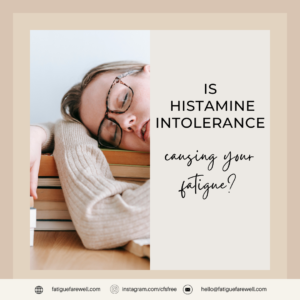While usually associated with classic, seasonal allergies, the topic of histamine is in fact much broader due to its ability to adversely affect parts of the population all year round.
Histamine intolerance can manifest in various ways when there is an excess in the body, impacting the gastrointestinal, respiratory, cardiovascular, and nervous systems, leading to many symptoms experienced by those with fatigue related conditions.
Symptoms can be debilitating, although can improve markedly once steps are taken to address its root causes.
Learning more about it is the first step in understanding whether it is worth considering in your journey back to health.
What is histamine?
Histamine is a chemical naturally produced by the body. Immune cells like mast cells release histamine in response to allergens as part of a normal immune reaction.
What is histamine intolerance?
Histamine can build up when the body overproduces it or can’t break it down efficiently. This imbalance can lead to symptoms such as fatigue, brain fog, anxiety, digestive issues, dizziness, headaches, temperature dysregulation and more.
Who is susceptible?
People experiencing gut dysfunction, a high environmental toxin load, stress or who have low amounts of the DAO enzyme can all be vulnerable to experiencing histamine intolerance.
What you can do
Lowering the body’s histamine load and increasing its capacity to deal with it is the first place to start.
Trialing a low histamine diet in addition to taking a DAO enzyme and antihistamines can assist. Some use over-the-counter options, while natural remedies like nettle, quercetin, and bromelain can also help.
Reducing sources of inflammation such as a malfunctioning gut, chronic infections and a high toxic load can all bring about sustained relief.
You can find other ME/CFS related blogs here.





2 Comments
Shannon
September 26, 2025I am having a lot of problems with too much histamine in my system. At least, this is what I believe the problem is. I’m very tired and my skin is very itchy. I am scratching my skin and scalp all the time. I take Benedryl to reduce the histamine. I am also very stressed. Any suggestions?
Shaun Moran
September 26, 2025Thank you for your comment, Shannon. There are several root causes for histamine issues in people ranging from gut dysfunction, toxic load to chronic infections. I have a free eBook available on my site which lists several tests which can help you pinpoint your root causes. If you have any trouble downloading it, please feel free to reach out to my team at hello@fatiguefarewell.com. Thank you!